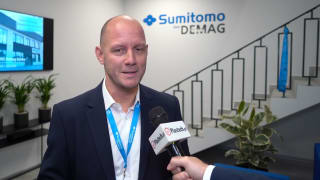 In essence, a cost-efficient, high-performance injection moulding solution involves an effective combination of machine and mould.
In essence, a cost-efficient, high-performance injection moulding solution involves an effective combination of machine and mould.Arburg, together with its co-operation partners Zahoransky and Foboha, presents two interesting examples of such combinations in the field of multi-component injection moul-ding on two large two-component Allrounders.
Arburg, together with the mouldmaking division of the Zahoransky Group, demonstrates a completely new and innovative mould technology. This involves a two-component version of an electric Allrounder 720 A with a clamping force of 3,200 kN and two injection units, one size 800 (horizontal) and one size 290 (vertical). Twelve toothbrush bodies made from PP with moulded-on TPE elements will be produced per cycle. The parts will be demoulded with the mould closed and removed by a pneumatic removal device from Barth. The cycle time for production of the twelve toothbrush bodies is around 20 seconds. The proportionate weight of the two components is 10 grams for the TPE portion and 6.15 grams for the PP portion.

The SCPS technology complements the mould systems used to date for multi-component injection moulding, such as rotating or stack-turning mould technology. The acronym stands for Servo Cavity Positioning System. Until now, the problem with these technologies was that the moulds needed to be very large. As a consequence, these large moulds necessitated machines with a correspondingly high clamping force, even though the products them¬selves did not require this.
With its SCPS technology, Zahoransky has deve¬loped a system that does not use the conventional rotating, interchangeable variants. The 12-cavity mould features special moulded part carriers on the ejector side, which are rolled vertically from station to station via a spindle drive.
Sequence: similar to a paternoster system
When the mould opens, the continuous system engages the part carriers in the cavities and transfers the preforms to the subsequent station. The preforms are injected at the first station. After opening of the mould, the preforms are transported into the final injection position by the moulded part carriers. Once the second component has been injected, the moulded part carrier carries the finished article to the removal position and removal takes place automati¬cally with the mould closed. The next injection takes place simultaneously. The empty moulded part carrier is transported back to the first station by means of a second spindle drive.
The main advantage: greater cost-efficiency
The principle advantage of the SCPS technology is that the moulds are only marginally larger than standard moulds. This means that they can also be used on standard machines with the optimum clamping force for the parts, without requiring any additional equipment. The innovative mould tech¬nology means that the investment costs for the machines remain reasonable because it is no longer necessary to use oversized machines as a result of the mould sizes. Likewise, there is no need to en¬large the clamping platens or installation dimensions. All movements in the mould, including those of core pulls and needle shut-off nozzles, are driven servo-electrically, making them independent of the machine technology. In turn, this means that there are no restrictions with regard to simultaneous machine movements, ensuring optimised cycle times. Finally, the application of force in the mould is absolutely central, which results in high-quality parts.


